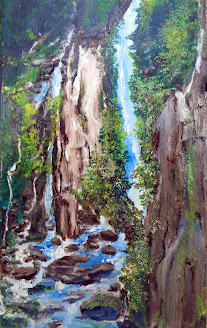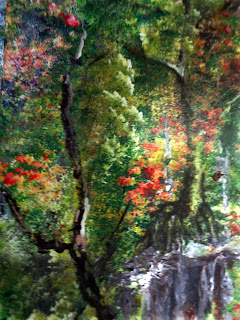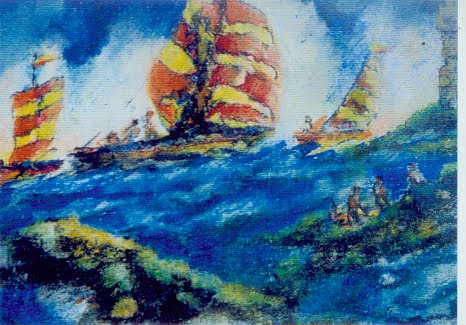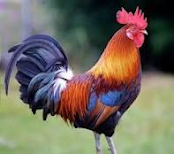Dr Abe V Rotor
Living with Nature School on Blog
Riddles may be based on truth and fantasy, the common and the rare, things we discover yet we can't understand, which we often attribute to the supernatural.
Here Dr Anselmo S Cabigan, a prominent Filipino scientist, is studying a rare plant. Its unique characteristic has led local folks to describe it in riddles. Do you know what plant is this? (See answer at end of article)
The word for riddle is burburtia in Ilocano, boniqueo in Pangasinan, bugtong in Tagalog or Pilipino, and in Pampangan, and tugmahanon in Bisayan.
Riddles are common to mankind, from earliest times to the present. Riddles delighted the old Aryans and the ancient Greeks. So with the modern Hindu and the Bantu people of Africa. Cultural influences gave riddles local and foreign flavors that their origin may not be easy to trace. One common characteristic of riddles is that they become adopted by different cultures by way of their languages and dialects.
Riddles are enduring like Homer’s epic, being transcended from generation to generation. Even as their popularity has declined with the rise of the academe and movement of people away from their native origin to live in cities, riddles are still part of conversation, and in fact with today’s social media, in comic books and animations. Riddles give life to discussions and conversations, and are often used in exchanging wit and humor.
A riddle is an indirect presentation of an unknown object, in order that the ingenuity of the hearer or reader may be exercised in finding it out.
Another definition is a play of wit, which endeavors to present an object, stating its characteristic features and peculiarities, giving some ideas about it to tease the mind, without actually naming it.
Riddles are part of cultures. There are Hebrew riddles in the Bible. Persian riddles, Indian riddles, Arabic riddles. Sanskrit and Gypsy riddles. One of the two Malayan collections is Rizal’s Specimens of Tagal Folk-Lore; the other is Sibree's paper upon the Oratory, Songs, Legends, and Folk-Tales of the Malagasy.
Some characteristics of Filipino Riddles.
1. Filipino riddles deal largely with animals, plants and objects of local character; such must have been made in the Islands even if influenced by Spanish models and ideas.
2. Many Filipino riddles are about God, saints and religious persons or objects, dismissing disrespect with expressions “sana walang magagalit, or “bato.bato sa langit ang matamaan huwag sana magalit,” two common expressions of excusing the story teller from blame or anger. It is not unusual that religious riddles lack reverence and sutlety.
3. There are Filipino riddles that lack finesse, in fact they display coarseness and even obscenity, but this is also a trend in many cultures and elsewhere, so that it is likely that foreign influence could be the reason for this undesirable characteristic that undermine the beauty and dignity of Filipino riddles.
4. Of several classes of Filipino riddles, the three most popular one are: concerning God and divine things (alo-divino); concerning persons (alo-humano) and fable (Parabula)
5. Filipino riddles are generally patterned after the true rhymed riddles and the short catch- questions’ expressed in prose. True riddles describe a veiled object, it is thought-arousing, poetical and sometimes misleading. Catch-questions are specific. There is also a third kind “false” riddles. Here the teller and listener fail to agree on the answer, and we can only imagine the consequence. That is why riddles as literature must follow certain criteria and code of ethics.
6. Filipino riddles in whatever language or dialect, are likely to be in poetical form. The commonest type is in two well-balanced, rhyming lines, although less exacting. Rizal says—ayup and pagud, aval and alam, rhyme. The commonest riddle verse contains five or seven, or six, syllables, thus:
 Here is a simple rhymed riddle.
Here is a simple rhymed riddle.
Contirad contibong; bandera ti lobong.
(Iloc.) Torre
(Sharp and long; flag of the world – tower).
Old tower (lighthouse) ruin in acrylic by AV Rotor, 2023
Here is a short list of popular Filipino Riddles:
Nagalacat nagahayang.
(Bis.) Sacayan
He walks with his back.
A ship
Ania ti pinarsua ni Apo Dios nga ipagnana ti bocotna?
(Iloc.) Baloto
What creature made by Lord God walks on its back?
Boat
Tinugtog co ang bangca nagsilapit ang isda.
(Tag.) Campana sa misa
I rang the banca and the fishes came.
Bell
Note: Banca is canoe or boat; to strike it as with the pole is to ring it. People are called to mass by the ringing of the bell, which is likened to fish.
These are two riddles about the bat.
Ania iti pinarsua iti Dios a balin suec a maturog?
(Iloc.) Panniqui
What thing that God made sleeps with its head down?
Bat
Pantas ca man, at marunong bumasa at sumulat, aling ibon dito sa mundo ang lumilipad ay sumususo ang anak?
(Tag.) Kabag
Although you are wise and know how to read and write, which bird in this world flies and yet suckles its young?
Bat
These are three riddles about the water buffalo or carabao in three dialects.
Uppat iti adiguina, maysa iti baotna, dua iti paypayna, dua iti boneng.
(Iloc.) Nuang
Four posts, one whip, two fans, and two bolos.
Carabao
Apat na tukod langit at isang pang hagupit.
(Tag.) Kalabao
Four earth posts, two air posts and whip.
Carabao
Saquey so torutoro duaray quepay-quepay a patiray mansobsoblay.
(Pang.) Dueg
One pointing, two moving, four changing.
Carabao
The head points, the ears move, the legs change position.
Here are riddles about the cock or rooster
Nagcapa dimet nagpadi; Nagcorona dimet nagari.
(Iloc.) Manoc
Gown but not priest; crown but not king.
Cock
Nancorona agimiet ari; nan capa agmuet pari.
(Pang.) Manoc
The king's crown but not king; the priest's cope, but not priest.
Cock
Dinay pinalsay Dios ya managtay carne?
(Pang.) Manoc
What creature of God is with meat on its head?
Cock
Ania a parsua ni Apo Dios ti nagsusoon ti carne nga aoan ti imana?
(Iloc.) Tapingar
What creature of our Lord God carries meat but has no hands?
Cock
The meat is the cock's comb.
 Now compare with the style of this riddle.
Now compare with the style of this riddle.
Nang munti ay may buntot nang lumakiy napugot.
(Tag.) Palaca
When he was little he had a tail but when he was grown he had none.
Frog
Here’s a tricky riddle
Casano iti panangtiliu iti ugsa a di masapul iti silo, aso, gayang, oen no a aniaman a paniliu?
(Iloc.) Urayec a maloto
How do you take a deer without net, dogs, spear, or other things for catching?
Cooked
And another one, this time playing with words.
Laguiung tao, laguiung manuc, delana ning me tung a yayup.
(Pamp.) Culassisi
The name of a man, the name of a chicken, were carried by a bird.
Culas is a man's name; sisi
These two riddles tell the answer, try to mislead.
Verdi ya balat, malutu ya laman anti mo ing pacuan.
(Pamp.) Pacuan
Its skin is green and its flesh is like a watermelon.
Watermelon
The riddle is poor, in that it introduces the answer as a term of comparison, in a way to mislead.
 Similar cases occur in this one.
Similar cases occur in this one.
Magma nagcal-logong no maibagam pag-ong.
(Iloc.) Pag-ong
Walking, wearing his hat.
Turtle
Analogy and anatomy
Nagsabong ti sinan malucong nagbunga uneg ti daga.
(Iloc.) Camote
It produces a flower like a cup; fruit underground.
Camote
Oquis nan bagasnan.
(Iloc.) Lasona
Its skin is its flesh
Onion
These are quite difficult, unless you are a farmer
Cobbo ni amam quiad ni inam sica nga anacda daramodum ca.
(Iloc.) Arado
The father is bent over, the mother is bent back and the son is bent forward.
Plow
This has reference to the different sticks, or pieces, of which the plow is composed
Adda maysa nga ubing a natured ti lammin.
(Iloc.) Sudo
There is a boy, who does not shiver with the cold.
Dipper
This dipper is made from the half of a polished cocoanut shell.
Adda abalbalayco a sinam granada rineppetco a binastabasta imbarsacco diay daga nasay sayaat ti cancionna.
(Iloc.) Sunay (tarampo)
I have a toy like a granada; I tied it around and around and threw it on the ground and it sang sweetly.
Spinning Top
Pusipusec ta pusegmo ta iruarco ta quinnanmo.
(Iloc.) Lacaza
I turn your navel to take out what you have eaten.
Trunk
Ania nga aldao ti caatid-dagan?
(Iloc.) Ti aldao a saan a panangan.
What day is the longest?
The day on which you do not eat.
Nag daan si Cabo negro, namatay na lahat ang tao.
(Tag.) Gabi
The black Corporal passed, all the people died.
Night
Died, here, is slept.
All about the stove
Tal-lo a pugot natured ti pudut.
(Iloc.) Dalican
Three ghosts endure much heat.
Stove
The three supports for the pot are meant. It seems that the pugot (ghost) is black.
Tatlong magkakapatid nagtitiis sa init.
(Tag.) Tungko nang calang
Three brothers suffering from the heat.
Pot rests
Tatlong mag kakapitid sing pupute nang dibdib.
(Tag.) Calan
Three sisters with equally white breasts.
Stove
They are equally white—i.e. they are all three black from the fire.
Nagcal-logong nag pica nagcaballo tallot sacana.
(Iloc.) Dalican
It has a hat and a spear, a horse and three feet.
Stove
Riddle about rain
Baston ni San Josep indi ma isip.
(Bis.) Ulan
Saint Joseph's canes cannot be counted.
Rain
Drops of rain in a tropical storm may well suggest rods or staves.
Buhoc ni Adan, hindi mabilang.
(Tag.) Ulan
Adam's hair cannot be counted.
Rain
How about shadow. (It reminds us of Peter Pan, who has no shadow)
No magnaac iti nasipnget aoan caduac quet no magnaac iti nalaoag adda caduac.
(Iloc.) Anninioan
If I walk in the dark I have no companion; if I walk in the light I have one.
Shadow
No tilioec tilioennac; no itarayac camatennac.
(Iloc.) Aninioan
If I catch, it catches; if I run away it chases me.
Shadow
Relationships make many riddles that need careful analysis. Here are examples
Ano ang itatawag mo sa biyenang babayi nang asawa nang kapatid mo?
(Tag.) Ina
What will you call the mother-in-law of your sister's husband?
Mother
Ang amain kong buo ay may isang kapatid na babayi, ngunit siyai hindi ko naman ali. Sino siya?
(Tag.) Aking ina
My uncle has a sister but she is not my aunt. Who is she?
My mother
Ang mga babaying A at B ay nakasalubong sa daan ng dalawang lalaki; at nagwika si A; naito na ang ating mga ama, mga ama nang ating mga anak; at mga tunay nating. (Tag.) Ang ama ni A ay napakasal kay B at ang ama ni B ay napakasal kay A at nagkaroon sila nang tigisang anak.
Ladies A and B met two men and said, “There come our fathers, fathers of our sons and our own husbands.”
A's father married with B and B's father with A, and each of them had a child.
Nang malapos nang madalao nang isang lalaki ang isang bilango ay tinanong nang bantay; ano mo ba ang tawong iyon? Kapatid mo ba o ano? Ang sagot nang bilango ay ito; akoy ualang kapatid, ni pamangkin ni amain, ni nuno, ni apo, ni kahit kaibigan; ngungit ang ama nang tawong iyan, ay anak nang anak nang aking ama. Ano nang bilango ang tawong iyon.
(Tag.) Anak
After a man visited a prisoner, the guard asked him—“is that man your brother, or what?” The prisoner's answer was, “I have no brother, no uncle, no nephew, no grandfather, neither grandson nor friend; but that man's father is my father's son. “Who was that man?
Son
Green corn riddle
Nag tapis nang nag tapis nacalitao ang bulbolis.
(Tag.) Mais
She wore and wore her tapis yet her pubic hair was displayed.
Maize
The green husks are considered the tapis, or wrap about the mid-body; the silk appearing from the husk wrapping is the pubic hair.
Lastly,
Aniat casam itan ti nasamit?
(Iloc.) Ayat
What is the sweetest of the sweet?
Love
The authors are deeply grateful to Project Gutenberg EBook of A Little Book of Filipino Riddles, by Various contributors, for allowing the use of some materials for this chapter. To wit: This eBook is for the use of anyone anywhere at no cost and with almost no restrictions whatsoever. You may copy it, give it away or re-use it under the terms of the Project Gutenberg License included with this eBook or online at www.gutenberg.net Thanks also to Philippine Studies I A Little Book of Filipino Riddles. Collected and Edited by Frederick Starr, World Book Co. Yonkers, New York 1909
Answer: Pongapong (Amarmophallus campanulatus) virtually dies losing all its stems and leaves completely, then produces a single huge flower emerging from its corm below the ground. The fower stinks and attracts flies to pollinate and disseminte its seeds. Now, how can you make a riddle out of this unique creature? ------------
* Lesson on former Paaralang Bayan sa Himpapawid with Ms Melly C Tenorio 738 DZRB AM, evening class 8 to 9, Monday to Friday.
Part 2 - Riddles for Kids (and Grownups, too)
Here are some examples. (Acknowledgement with thanks: Jokes to Tell, a pocket book for Children, and Internet for the cartoons)
1. What did one wall say to the other?
I'll meet you at the corner.
2. What did the stamp say to the envelope?
Stick with me and we'll go places.
3. What do Alexander the Great and Kermit the Frog have in common?
The same middle name.
4. What has four legs but can't walk?
A table.
5. What sort of star is dangerous?
Shooting star.
6. What kind of music does you father like to sing?
Pop music.
7. Can February March?
No. But April May.
8. What has two hands, no fingers, stands still snd runs?
A clock.
9. How can you tell if a Martian is a good gardener?
All Martians have green thumbs.
10. What do you call a vampire's dog?
Blood Hound.
11. Doctor, doctor, I feel like a dog.
Then go see a vet.
12. Doctor, doctor, I keep thinking I'm a dog.
How long has this been going on?
Ever since I was a pup.
13. What kind of dress can never be worn?
Address.
14, What can you serve, but never eat?
A volleyball.
15. What is always coming but never arrives?
16. What has teeth but cannot eat?
A comb.






























































